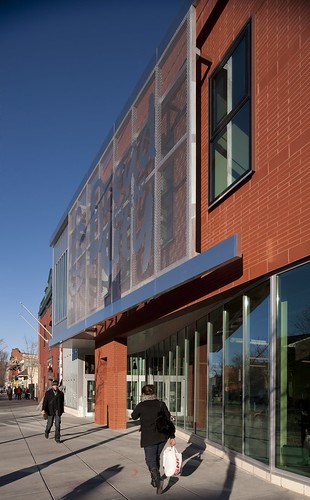 You should check out the newest edition of Architecture DC magazine, because Bread for the City is totally in it! (It's only available in PDF format, so you'll have to go to page 32 of this file.)
You should check out the newest edition of Architecture DC magazine, because Bread for the City is totally in it! (It's only available in PDF format, so you'll have to go to page 32 of this file.)
Congratulations to our longtime partner-in-building, architect Kendall Dorman, who designed our Northwest center expansion; Kendall also worked with us to redesign the original facilities of both our Southeast and Northwest Centers, so we believe that his firm Wiebenson & Dorman deserves all this attention and more.
The theme of this issue of Architecture DC is "non-profit architecture," and indeed this article explores the ways in which the design of our new building reflects the character and structure of Bread for the City itself. See this excerpt:
The theme of this issue of Architecture DC is "non-profit architecture," and indeed this article explores the ways in which the design of our new building reflects the character and structure of Bread for the City itself. See this excerpt:
The double-height atrium houses the main front and rear entrances, reception, and vertical circulation (an elevator and open stair), with direct entrances to the medical/dental clinic, the legal clinic, the food bank, board room, social services, and administration.... [T]he interiors are in a “loft” style, in which the necessities of structure, ducts, piping, cable conduits, and the like are exposed and painted white. They become the “ornament” of the space. The entire former exterior brick wall ofthe lumber warehouse building is exposed as the north wall of the atrium. Its solidity is offset by the glassiness of the end walls of the atrium, and balanced by the exposed concrete block elevator tower....Color is important throughout the project, but used sparingly both for reasons of economy and effect. This starts with the streetfront windows, which have alternating green and blue tints. It continues with the surprisingly bold green linoleum flooring and carpet tiles, and accent walls painted green, blue, or gold, including one wall of each medical exam room. Doors and simple pieces of custom millwork, such as bookshelves, are natural, warm wood tones. Because most of the interiors are white, the colors add “pop” and distinction to the spaces.
The article also discusses our "LEED-like" energy efficiency, our innovative green roof (you'll hear even more about that soon...), and the strange but true fact that all this was made possible by the 1998 Tobacco Master Settlement Agreement. Take a read, page 32.
Photos courtesy of John Cole.






No comments:
Post a Comment